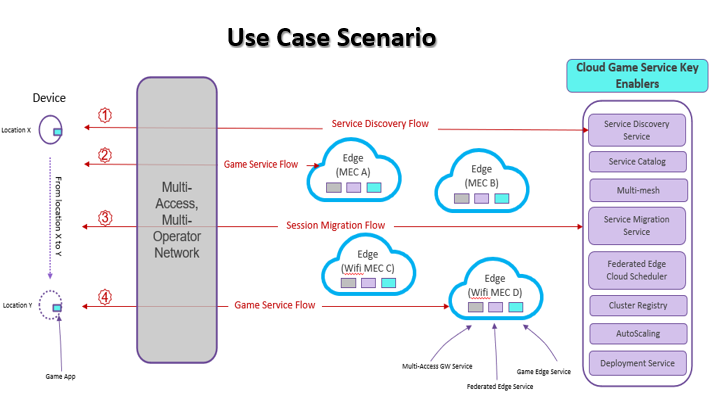Introduction
This blog focuses on providing an overview of the “Federated Multi-Access Edge Cloud Platform” blueprint as part of the Akraino Public Cloud Edge Interface (PCEI) blueprint family. This blog specifically provides an overview of the key features and implemented components as part of Akraino Release-5. Key idea for this blueprint is to have a federated Multi-Access Edge Cloud (MEC) Platform that showcases the inter-play between telco side and cloud/edge side.
Prior to discussing the specifics of this blueprint implementation, the following subsection provides a brief description of what Multi-Access Edge Cloud (MEC) is and how it is ushering in as an enabler for emerging 5G/AI based applications landscape.
What is MEC and the challenges?
MEC is a network architecture concept that enables cloud computing and IT capabilities to run at the edge of the network. Applications or services running on the edge nodes – which are closer to end users – instead of on the cloud, can enjoy the benefits of lower latency and enhanced end-user experience. MEC essentially moves the intelligence and service control from centralized data centers to the edge of the network – closer to the users. Instead of backhauling all the data to a central site for processing, it can be analyzed, processed, stored locally and shared upstream when needed. MEC solutions are closely “integrated” with access network(s). Such environments often include WiFi, mobile access protocols such as 4G-LTE/5G etc.
MEC opens up plethora of potential vertical and horizontal use cases, such as Autonomous Vehicle (AV), Augmented Reality (AR) and Virtual Reality (VR), Gaming, and Artificial Intelligence (AI), Machine Learning (ML), and Deep Learning (DL) enabled applications like autonomous navigation, remote monitoring by using Natural Language Processing (NLP) or facial recognition, video analysis, and more. These emerging 5G/AI based applications landscape typically exhibit characteristics such as the following:
- Low Latency requirements
- Mobility
- Location Awareness
- Privacy/Security etc.
All of these characteristics pose unique challenges while developing emerging 5G/AI applications at the network edge. Supporting such an extensive feature-set at the required flexibility, dynamicity, performance, and efficiency requires careful and expensive engineering effort and needs adoption of new ways of architecting the enabler technology landscape.
To this regards, our proposed “Federated Multi-Access Edge Cloud Platform” blueprint enables desired abstractions in order to address these challenges and, as a result, ushers in an application development environment that enables support for ease of development and deployment of these emerging applications landscape. Subsequent sections delve deep into the proposed “Federated Multi-Access Edge Cloud Platform” blueprint details.
Blueprint Overview: Federated Multi-Access Edge Cloud Platform
The purpose of the “Federated Multi-Access Edge Cloud Platform” blueprint is an end-to-end technology solution for mobile game deployed across multiple heterogeneous edge nodes using various network access protocols such as mobile and WiFi and others. This blueprint demonstrates how an application leverages a distributed and multi access network edge environment in order to get all the benefits of edge computing.
The diagram above highlights the use case scenario. On the left hand side is the device – as can be seen that the device is moving from location x to y.
The whole use case goes through 4 distinct steps. The first step is the service discovery flow. And then the game service flow follows. And once the device actually moves, it would trigger additional session migration flow. This also includes subsequent service discovery to go along with this session migration. Finally, step number four is once this migration happens, the UE will go to the new edge node.
In order to support all this, platform provides two key abstractions:
- Multi-Access/Mobile Operator Network Abstraction: Multi-access network means a mobile, Wi Fi or whatever it takes. Multi-operator means even for the same 4G/5G there could be different operators (Verizon, AT&T etc.). There are various MEC edge nodes, they could be the WiFi based edge node and they can be from different operators.
- Cloud-Side Abstraction: Cloud side abstraction includes key architectural components to be described in the subsequent sections.
